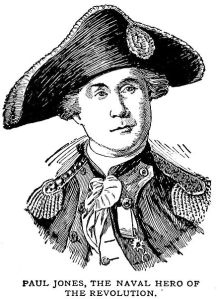 John Paul “Jones” was born in a small cottage on the southern coast of Scotland on July 6, 1747 the son of a gardener. When he was not more than thirteen, he apprenticed himself to serve aboard a sailing vessel under the command of captain Benson. For a good portion of his early life he served aboard various merchant and slaver ships until he became disgusted as his English contemporary John Newton had been of the slave trade. After abandoning the blossoming enterprise with the slaver ship Two Friends in Jamaica, he boarded a ship for Scotland and soon took up another position. While sailing with the brig John in 1768, John Paul Jones was thrust in the position of commanding and sailing the ship after both its captain and first mate were taken by yellow fever. He safely brought the ship back and was rewarded handsomely for his bravery and seamanship with 10% of the ship’s cargo and became the owner of the ship and crew.
John Paul “Jones” was born in a small cottage on the southern coast of Scotland on July 6, 1747 the son of a gardener. When he was not more than thirteen, he apprenticed himself to serve aboard a sailing vessel under the command of captain Benson. For a good portion of his early life he served aboard various merchant and slaver ships until he became disgusted as his English contemporary John Newton had been of the slave trade. After abandoning the blossoming enterprise with the slaver ship Two Friends in Jamaica, he boarded a ship for Scotland and soon took up another position. While sailing with the brig John in 1768, John Paul Jones was thrust in the position of commanding and sailing the ship after both its captain and first mate were taken by yellow fever. He safely brought the ship back and was rewarded handsomely for his bravery and seamanship with 10% of the ship’s cargo and became the owner of the ship and crew.
From that point on, John Paul Jones was noticed as a good seaman and captain and more than anything, as fiery a Scot as ever. He came close to being court martialed several times after taking several disciplinary actions that were harsh and in some cases, quite necessary. Nevertheless, his reputation was marked with his fiery disposition and harsh discipline and he soon left Scotland for the American colonies. He soon settled in Fredericksburg, Virginia where his brother once lived. It was here that he picked up the additional surname Jones. He became quite attached to his new country and soon joined the Revolution by volunteering for the Continental Navy. Due to his friendship with Richard Henry Lee, he was put forth as 1st Lieutenant aboard the Alfred since officers and captains were needed for the new founded navy.
Jones was put to good use during the early years of the Navy and won many victories over Britain. As before his move to America, he moved between different ships, the USS Alfred and especially the USS Providence upon which he captured sixteen prizes and inflicted serious damage in Nova Scotia to free many American prisoners. He soon took command of the Ranger, which was honored by the French as they joined the Colonies in their fight for Independence. He took the Ranger into British waters and harassed the British merchant vessels in the Irish Sea and even along the coast of Scotland in 1778. He inflicted a small amount of damage in Whitehaven and St. Mary’s Isle and tried to hold for ransom the Earl of Selkirk in his birth town of Kirkcudbright.
Shortly after this excursion into British waters, Jones was given the command of the USS Bonhomme Richard in 1779. Within this year he famously engaged the British warship HMS Serapis at the battle of Flamborough Head. He began engaging the enemy at a short distance and realized he couldn’t win with outmatched guns and little wind so he decided to lock up with the enemy’s rigging. After doing so, he directed his deck guns and sharpshooters to clear the British deck. It was within this moment that he uttered his famous cry, “I have not yet begun to fight!” The USS Alliance came around to help the Bonhomme Richard and fired two broadsides that damaged the Bonhomme Richard as well as the Serapis. Due to this and a mistake by a British grenade, the Serapis surrendered to the Americans. The Bonhomme Richard‘s damage was so bad that it sank two days after the battle and the crew moved to the other ships in the convoy. They soon sailed to Holland to refit. Soon after, he was awarded and congratulated by the French and Americans. Though he didn’t stay in America, his efforts to further our Independence are continuously appreciated.
John Paul Jones went to fight for the Russian Navy shortly after the American Revolution and remained there until 1788 being awarded the Order of St. Anne. He lived in Paris the rest of his life where he died of a brain tumor in July 18, 1792. He was buried in Paris but was later unearthed in 1905 to be returned to the United States where he lies buried in the Naval Academy in Annapolis, Maryland.

A good historical post. What is the “order of St. Anne”?
The Order of St. Anne is a Russian order of chivalry awarded to those who served with a distinguishing career in civil service and for those who were valorous and distinguished in the military.